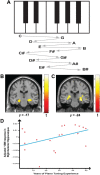Navigating the auditory scene: an expert role for the hippocampus
- PMID: 22933806
- PMCID: PMC3448926
- DOI: 10.1523/JNEUROSCI.0082-12.2012
Navigating the auditory scene: an expert role for the hippocampus
Abstract
Over a typical career piano tuners spend tens of thousands of hours exploring a specialized acoustic environment. Tuning requires accurate perception and adjustment of beats in two-note chords that serve as a navigational device to move between points in previously learned acoustic scenes. It is a two-stage process that depends on the following: first, selective listening to beats within frequency windows, and, second, the subsequent use of those beats to navigate through a complex soundscape. The neuroanatomical substrates underlying brain specialization for such fundamental organization of sound scenes are unknown. Here, we demonstrate that professional piano tuners are significantly better than controls matched for age and musical ability on a psychophysical task simulating active listening to beats within frequency windows that is based on amplitude modulation rate discrimination. Tuners show a categorical increase in gray matter volume in the right frontal operculum and right superior temporal lobe. Tuners also show a striking enhancement of gray matter volume in the anterior hippocampus, parahippocampal gyrus, and superior temporal gyrus, and an increase in white matter volume in the posterior hippocampus as a function of years of tuning experience. The relationship with gray matter volume is sensitive to years of tuning experience and starting age but not actual age or level of musicality. Our findings support a role for a core set of regions in the hippocampus and superior temporal cortex in skilled exploration of complex sound scenes in which precise sound "templates" are encoded and consolidated into memory over time in an experience-dependent manner.
Figures


References
-
- Amaral DG, Insausti R, Cowan WM. Evidence for a direct projection from the superior temporal gyrus to the entorhinal cortex in the monkey. Brain Res. 1983;275:263–277. - PubMed
-
- Ashburner J. A fast diffeomorphic image registration algorithm. Neuroimage. 2007;38:95–113. - PubMed
-
- Ashburner J, Friston KJ. Voxel-based morphometry—the methods. Neuroimage. 2000;11:805–821. - PubMed
-
- Bermudez P, Zatorre RJ. Differences in gray matter between musicians and nonmusicians. Ann NY Acad Sci. 2005;1060:395–399. - PubMed
-
- Blatt GJ, Pandya DN, Rosene DL. Parcellation of cortical afferents to three distinct sectors in the parahippocampal gyrus of the rhesus monkey: an anatomical and neurophysiological study. J Comp Neurol. 2003;466:161–179. - PubMed
Publication types
MeSH terms
Grants and funding
LinkOut - more resources
Full Text Sources
Other Literature Sources
